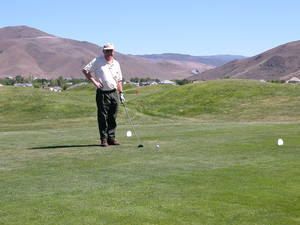It took me several years of playing golf to understand why people take a practice swing before hitting the golf ball. I thought at first it was to show off, to build wrist strength, lack of confidence, inability to watch the ball, or the desire to focus concentration. Many of these are good reasons for a practice swing, but they aren’t the primary ones.
To understand the practice swing, you need to be able to take apart your golf swing and understand what is happening at each stage. The setup places your tee height, positions your feet, your club position, and your reach. The back swing winds the club up and sets you up to power through. The downward stroke is meant to hit the ball squarely at the bottom of your swing. The follow through establishes direction, and in some cases, upward arc.
The primary goal of every golfer is to have a perfect swing. The perfect swing involves a number of things. A perfect swing minimizes any resistance. Resistance comes when you change direction, impact a surface, hit the ball awkwardly, or if your muscles fight the action.
Align Your Shoulder to Point to the Ball’s Destination
You should stand perpendicular to where you want the ball to go. A good test is to position yourself and look over your left shoulder. Once I’ve assured myself that I am lined up to hit to the ball’s destination, I never have to look at where it’s going again until after I’ve hit the ball. People who continually look at the destination are likely to not watch the ball. To hit the ball cleanly, you have to keep your eye on the ball and not move your head.
Place Your Tee
You will soon know the perfect height for your tee if you practice enough. If I look at the tee box or lie and see that the ball is below my feet, i.e. the surface is sloped downward, I will often raise the tee. If the ball is above my feet, i.e. the surface is sloped upward, I will often lower my average tee height.
Select Your Reach
I place the club head so it sits flat on the ground and I’m shaking hands with the shaft. My arms are straight. My wrists are lifted. This establishes how far to stand from the ball. Foot separation should not be any wider than shoulder height. Terry Edward’s article “Practice with Purpose” provides a good drill on maintaining balance in your swing.
Visualize Your Swing
This rule mostly applies to my irons. When I go to hit them, I always think “U”. This helps remind me to not swing to far back and to use my wrist on the follow through. It also establishes a line of flight through the ball. Charles Thompson’s article “Develop Your Swing the Right Way” provides more tips on actual swing mechanics.
Check for the Bottom of Your Swing
There are a number of rules of thumb about where to place the ball in relation to your feet. I forget these rules for the most part, especially since I can never remember right from left. Typically, the driver goes closer to my forward toe, and my seven wood midway between my feet. I estimate where my feet position should be for my practice swing stepped back from the ball’s setup by a foot or more. The number one thing I do during my practice swing is to check where the bottom of my swing falls. If I hit dirt, if the club passes a spot forward or backward from the balls lie, I immediately reposition my feet until my club passes over a spot lined up with the ball.
Check for the Effect of the Turf
In deep grass, if my club head hangs up in the turf I may choose a different club. If I need the distance of a driver, I will often switch to a seven-wood since the higher angle helps pull through turf. I rarely use a four-wood in heavy turf because it won’t make it through. If I’m using an iron, the highest iron I will use is a six-iron. I won’t use a sand wedge in heavy turf or against a hill.
Check for Your Follow Through
After you have swung, I always stop at the top of the swing and point my club. If my club isn’t pointing at the flag, it means something about the lie is pulling my club one way or the other. This is true for all of the strange lies. I then adjust my feet until the club points at the flag. For balls lying below my feet, I often put all of my weight on my back foot; this helps level the swing against the angles.
Pay Attention to Your Practice Swing
If you follow these tips during your practice swing, you will find that your ball is less likely to curve or go in the wrong direction when you hit the ball.




